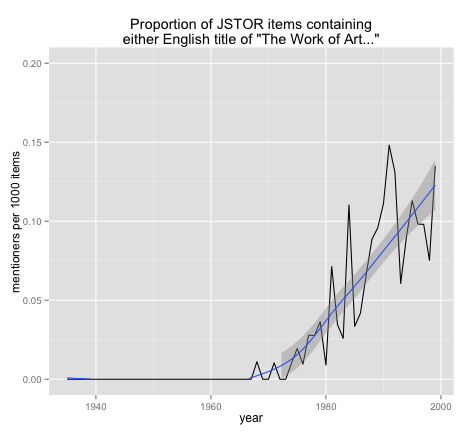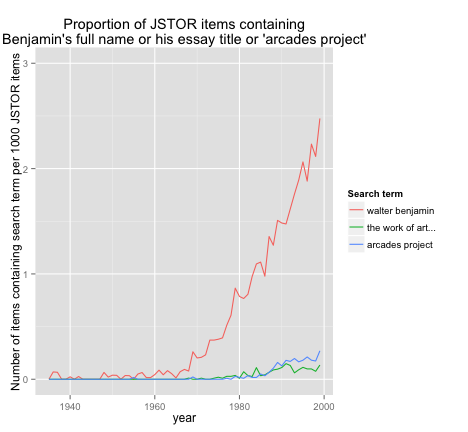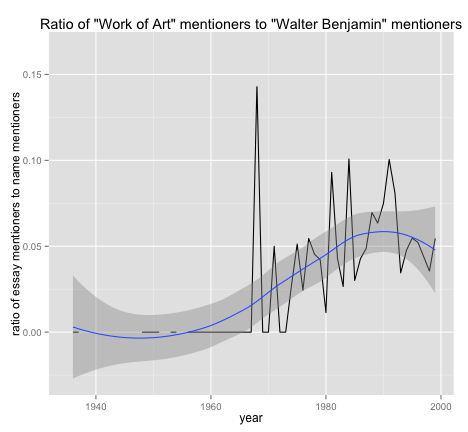Mass Mechanical Reproduction of S of Original Works of Art
This post could also be chosen: Walter Benjamin in the Historic period of Me Noodling Effectually with Small-scale Data.
On Monday I participated in a roundtable discussing Walter Benjamin's essay "The Work of Art in the Age of Its Technological Reproducibility"/"The Work of Fine art in the Age of Mechanical Reproduction." Rereading this essay after not having looked at it in 5 years or then, I was struck by the degree to which Benjamin anticipated (or, ameliorate, laid the groundwork for) both the rhetoric and the analytic procedures of contemporary historicist literary criticism and cultural studies: analogous big social-structural changes with changes in artistic genres and artistic values;attending to popular culture alongside high civilisation; and, especially, announcing the imperative to "politicize fine art." This is not quite as banal as might seem—afterward all, Benjamin was not an bookish, and this famous essay is not a piece of work of literary criticism or of philology. Anyway information technology fabricated me desire to think more almost the reception history of this essay.
I had wanted to bring to that roundtable a couple of quick factoids from that reception history using JSTOR's archive of scholarly journals. I didn't quite manage the nice handout I envisioned, but as I put together my remarks I gathered a fiddling data, and so this mail service relates the explorations I fabricated.
Using the JSTOR Data for Research interface, I downloaded metadata for all JSTOR items (articles, book reviews, etc.) that included ane of the following strings (case-insensitive):
- walter benjamin
- work of art in the age of its technological reproducibility
- work of fine art in the age of mechanical reproduction
With the help of scripts I'd developed earlier, I compared the frequency of items with these strings in them over time. (N.B. None of these search strings is a perfect indicator of the entity information technology appears to refer to. Benjamin is oft called just "Benjamin," but automatically disambiguating the Benjamin from all the Benjamins of the globe is no simple job. And the two essay titles, because they are equanimous of many tokens, have, I'd assume, a higher probability of existence distorted past OCR errors as well as a lower "natural" [Zipf'south police] probability of occurrence.)
Hither are the totals:
- walter benjamin all items: 8200; articles: 5006
- piece of work of fine art in the age of mechanical reproduction all items: 410; manufactures: 353
- work of art in the age of its technological reproducibility all items: 111; manufactures: 97
As it turns out, the alternating essay titles are co-mentioned in just a scattering of items, so the full number of mentions of either English title is
Either English language title of "The Work of Art..." all items: 517; articles: 447
The sheer number of these mentions (and their steady increment over time, as we'll see below) gives an indication that Benjamin's essay is canonical for scholarship, a recurrent point of reference. To capeesh what this ways qualitatively, you lot could notice that in the essay's latest English version, at the head of a book of selected writings on media, the get-go mention of Marx receives an explanatory annotation (Walter Benjamin, "The Work of Art in the Age of Its Technological Reproducibility," in The Work of Fine art in the Age of Its Technological Reproducibility, and Other Writings on Media [Cambridge: Harvard, 2008], 43n. 2). But you lot could as well track the essay'south continuing rise in mentions over time:

(I accept divided each yearly count by the total number of items in JSTOR for that year, which of course also increases with fourth dimension, to give a sense of the essay's increasing share of attention.)
It is also continuously important though not dominant in the reception of Benjamin's œuvre, which we can encounter by comparing the frequency of items mentioning "Walter Benjamin" to those mentioning his essay:

Another fashion to do this comparison is to wait at the ratio of these two frequencies with a smoothing line added:

Though "The Work of Art" is important in Benjamin's reception, The Arcades Projection has caught up over fourth dimension:

Still, at that place is one "Work of Fine art" -mentioner for every x to 20 "Walter Benjamin"-mentioners in about years from 1970 onwards. That strikes me as a fairly substantial representation in Benjamin-reception for a unmarried short essay known best equally role of Illuminations.
For comparison, I chose more or less at random some other critical chestnut of "theory" from roughly the same menses, "The Intentional Fallacy." Though items mentioning "intentional fallacy" are about ten times more frequent than items with "piece of work of art in the age of mechanical reproduction," this term does not show the up trend of Benjamin's works in JSTOR:

Thus this preliminary assay indicates the scope of Benjamin's influence in the journals archived by JSTOR, and the prominence of "The Work of Fine art" within it.
So far, then simple, yet at that place is a not-Benjaminian lesson to draw here, I call up. The reception of Benjamin's work tells a different story about culture in the "age of technical reproducibility" than the essay itself does. Benjamin'due south essay posits a transformation in the nature of the artwork resulting from the weather condition of technical reproducibility. For Benjamin, this transformation entails at least ii things. Beginning, the decay of aura, which, he claims, eliminates "all semblance of art'south autonomy" (28). 2nd, the opportunity for revolutionary intellectuals to "politicize art," dialectically reversing fascism's aestheticization of politics (42). I believe the entreatment of these two moves in literary studies since the 1970s has had to practice with their overestimation of the ability of the private critical-interpretive human activity. Benjamin performs a stunning bound from noting a broad (and dubious: every bit anybody knows, impress reproducibility is non a nineteenth-century innovation) technological transformation to a claim most irresolute cultural values; this same jump allows him to claim political urgency for a discussion of aesthetics. And this gesture of politicizing art has become familiar, fifty-fifty ritualized, in literary and cultural criticism.
What has dropped out of the picture show is precisely the long chain of mediating processes between the technologies of cultural reproduction and the many domains of values and judgments (aesthetic, cultural, political…). What kind of mediating processes? Processes similar (in the case of texts) publishing and republishing, reviewing, canonization, re-reading, critical appreciation and appropriation. These are not processes of re-product except in a very broad sense. They are, rather, processes of cultural production (of meanings, of farther texts, of status, fifty-fifty of…the "semblance of [relative] autonomy"). To follow Benjamin's emphasis on reproducibility and its relation to the singular artwork is to obscure an equally consequential transformation: the last century'due south massive increase in the number and diversity of cultural products. There are more and more photographs, songs, novels…and scholarly manufactures. (Moving picture production does not increase as dramatically, however.) the world of scholarship does witnesses this increase:

In that location are hundreds of scholarly responses to "The Work of Art…," thousands of scholarly texts that mention Benjamin'south proper noun in JSTOR-digitized impress. This is not an account of the work of art in the age of mechanical reproduction. It is "The Work of Art" in the historic period of technically facilitated cultural production on an unprecedented and ever-increasing scale.
Source: https://arcade.stanford.edu/blogs/benjamins-work-art-age-production
0 Response to "Mass Mechanical Reproduction of S of Original Works of Art"
Post a Comment